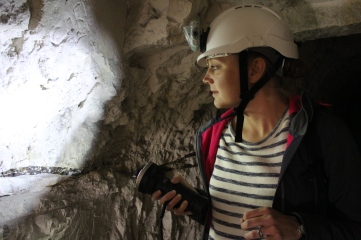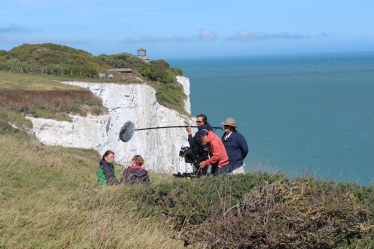

| Online: | |
| Visits: | |
| Stories: |

| Story Views | |
| Now: | |
| Last Hour: | |
| Last 24 Hours: | |
| Total: | |
Walking Through Time
Nearly three years ago, two researchers uncovered a series of footprints on a beach in Happisburgh, Norfolk. Preserved for at least 800,000 years beneath layers of sediment, the footprints had been exposed by recent storms. There was just enough time to record 3D images of them before they were swallowed up by the tide.

Photographs of Area A at Happisburgh. a. Footprint surface looking north-east. b. Detail of footprint surface. Photos: Martin Bates. (Wikipedia)
The prints – around 50 of them, some partial, some complete with the imprints of toes – meandered through what would once have been a river bed. Approximately five individuals, adults and children of both sexes, winding their way south along the mudflats, perhaps searching for seafood.
 ‘We always think about geological time as being not on a human scale’ says Dr Tori Herridge, presenter of ‘Walking Through Time’ (Channel 4, Saturday 6th February, 8 pm), which opens with a closer look at the Happisburgh prints. ‘Which is true – but there are moments which are real, and leave their mark.
‘We always think about geological time as being not on a human scale’ says Dr Tori Herridge, presenter of ‘Walking Through Time’ (Channel 4, Saturday 6th February, 8 pm), which opens with a closer look at the Happisburgh prints. ‘Which is true – but there are moments which are real, and leave their mark.
‘You get stopped in your tracks, because you think of geology as slow moving, but what we’re actually capturing when we uncover evidence like this are moments. In this case, a few individuals walking along a river bank. Footprints buried and eroded out, visible for a brief moment before they’re washed away.’
At the time the prints were made, Britain was not an island but a peninsula of Europe, joined by a land bridge to France. It is thought that the individuals who made them were migrants, adapting themselves to the colder northern climate. Theirs are the earliest known human footprints outside of Africa.
Megaflood
Another moment in geological time – the catastrophic flooding which erased that land bridge – is the subject of ‘Walking Through Time’, which airs this Saturday. Thought to have taken place 450,000 years ago, the massive inundation changed the course of Britain’s history, isolating it from Europe. By visiting sites around the country, Herridge explores how Britain changed before and after the megaflood, and examines the evidence for how and when it happened.
‘After that, everything changes’ she says. But the event itself would have been relatively, geologically speaking, brief.
‘It would have involved huge volumes of water – unimaginable volumes. Hundreds of times the power of Niagra Falls, pouring over the ridge between Calais and Dover. That kind of event, the scale of it, is rarely seen in human history, but it would have been momentary. Perhaps a matter of weeks or months.’
The evidence for this flooding event is largely unseen – canyons and river channels beneath the English Channel, punctuated by tear drop shaped islands. Recent research by Jenny Collier, who features in the programme, demonstrates that these island structures were carved from the bedrock, suggesting massive flooding was the cause.
Fossil hunters

Walking Through Time BTS 2 Behind the scene shot of Dr Tori Herridge & crew at the White Cliffs of Dover c. Renegade Pictures
As well as research by professional scientists, Herridge hopes the programme will highlight the important work carried out by amateur researchers.
‘We make a deliberate attempt not to separate the two. We’ve avoided scenes set in laboratories – the programme is about fieldwork, and making discoveries yourself. This is what makes geology fun – the camaraderie, the accessibility.’
Among Herridge’s interviewees is Margaret Hems, discoverer with her husband of the West Runton Mammoth. The Hems were skilled amateur palaeontologists, who searched their local area following stormy weather, looking for fossils. The large bone they discovered in December 1990 turned out to be the start of a major three month excavation, uncovering an 85% complete specimen.
Like the Happisburgh footprints, the mammoth is evidence of Britain’s pre-island past. Like the footprints, it was uncovered on the Norfolk coast following storms and, like the footprints, it preserves a moment in time. A male steppe mammoth in its prime, succumbing to a leg injury around 700,000 years ago and preserved beneath layers of sediment – but not before its body had been scavenged by hyenas, whose skeletons were also discovered at the site.
‘Discoveries like this help us understand how relevant geology is today’ says Herridge. ‘We shouldn’t separate ourselves from the geological present. We shouldn’t forget that features which seem permanent aren’t – things can change in an instant, and have a lasting effect.
‘I hope that, after seeing the programme, when people next go out walking and hiking and look around them, they realise they can join in themselves. There are beautiful places in Britain you can visit, which hold fascinating secrets about our past.’
![]()
Source: http://blog.geolsoc.org.uk/2016/02/04/walking-through-time/




